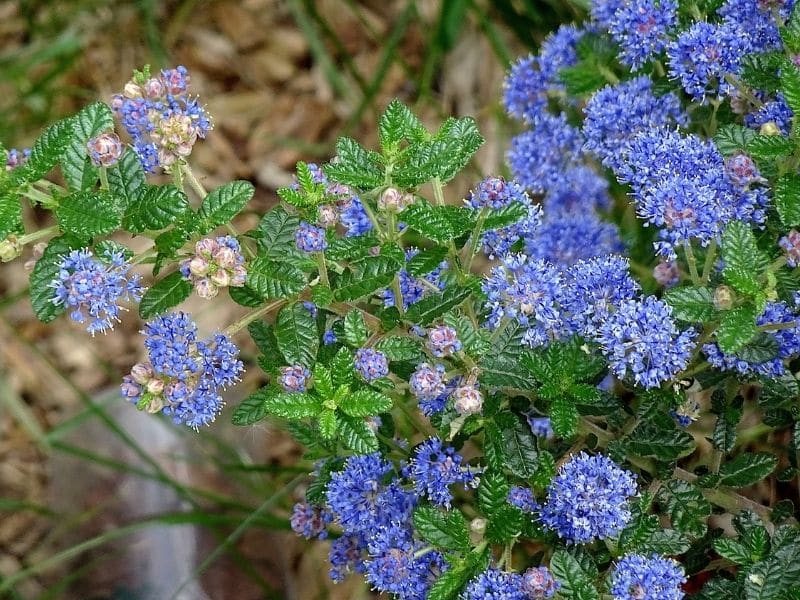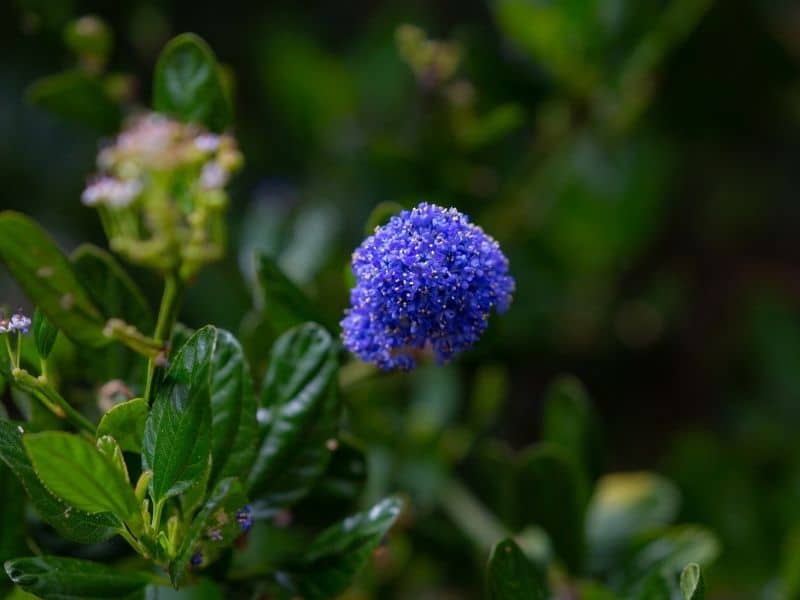Ceanothus plants are some of the most beautiful native shrubs available to the gardener. With so many spectacular and fragrant species and cultivars available, the choice is yours as to how you want to use this fast growing evergreen or deciduous plant in your landscape.
Read on to learn more about how to grow and care for these plants.
What Is A Ceanothus?
Many Ceanothus species, pronounced see-uh-now-thuhs, are a genus of flowering native plants from North and Central America. Most species of these attractive evergreens or deciduous plants come from the west of the United States and many of them make great gardening subjects.
There are between 50 and 60 species of ceanothus, and common names include California lilac, buckbrush, bluebossom, wild lilac, mountain lilac, and soapbush.

These shrubs or small trees are in the Rhamnaceae (Buckthorn) family and vary widely in size and shape from tree forms of up to 30 ft (9 m) and prostrate forms of less than 1 ft (0.3 m). They also grow in a variety of habitats, depending on the species.
Ceanothus leaves are oppositely or alternately arranged and have glossy upper surfaces. The leaves have serrated edges that help the plant to reduce water loss through transpiration. The plants are usually not particularly long-lived and 10 to 15 years is the normal lifespan you can expect.
Ceanothus Flowers
Ceanothus plants (Ceanothus spp) put on a delightful floral display that impresses anyone who sees it. Individual flowers have 5 sepals and 5 petals. On their own, these flowers are pretty small and insignificant but in dense clusters, the effect is impressive and showy.
Ceanothus flowers are usually bright blue, but pink, purple, and white varieties can also be found. The most common flowering period for these plants is from early spring to summer, but a few cultivars will bloom from early summer to fall, but this depends on the species and cultivar involved.
The fragrance of these flower clusters varies from mild to intense, depending on cultivar, so it’s worth considering this when choosing a spot to grow this plant.

Selected Ceanothus Varieties and Species
Ground Covers
- Ceanothus thyrsiflorus var. repens – The creeping blue blossom is a superb evergreen groundcover plant that grows to a maximum of around 3 ft (0.9 m) tall and 10 ft (3 m) wide. These plants flower profusely and appear to be all blue when in bloom.
- C. griseus var. horizontalis – The carmel creeper ceanothus is another great groundcover plant that reaches about 2 ft (0.6 m) tall and up to 15 ft (4.5 m) wide.
Shrubs
- Ceanothus americanus – This plant, which is commonly known as New Jersey tea is cold hardier than the other species. This is a deciduous shrub that grows to a height of a little over 3 ft (0.9 m) and produces fragrant white flowers.
- C. cuneatus – The buckbrush is a fragrant, white-flowered species that needs little maintenance and grows fast. This deer-resistant shrub usually grows from 5 to 12 ft (1.5 to 3.6 m) tall.
- C. ‘concha’ – This spectacular but relatively short-lived plant is a hybrid between C. papillosus and C. impressus. The concha ceanothus is a dense shrub that grows to about 8 ft (2.4 m) tall and 12 ft (3.6 m) wide in ideal conditions.
- C. ‘El Dorado’- This cultivar has attractive variegated evergreen leaves and grows as an upright shrub up to about 8 ft (2.4 m) tall and wide.
- C. ‘Julia Phelps’- The small leaf mountain lilac is a highly drought-tolerant variety with very small leaves of only around half an inch (12 mm) in length. This evergreen shrub, like so many other ceanothus plants, puts on a tremendous show with its blue blossoms. This flowering plant grows to about 8 ft (2.4 m) tall and 12 ft (3.6 m) across.
Large Shrubs or Trees
- C. arboreus – The fetleaf or island ceanothus is a large species that can reach impressive heights of over 30 ft (9 m). This plant produces masses of lilac blue flowers in the fall. ‘Trewithen Blue’ is a very popular cultivar of this species that produces darker flowers.
- C. ‘Ray Hartman’- This large ceanothus is a hybrid of C. arboreus and C. griseus. These plants are generally quite tolerant of a variety of conditions and can grow up to 20 ft (6 m) tall and wide at a relatively fast rate.
How To Grow A Ceanothus Shrub
Although California lilacs can be grown from seed that is pre-soaked in warm water, this can be challenging because the seeds often require cold stratification or smoke treatments to become fertile. (1)
An easier way to propagate new deciduous or semi-deciduous ceanothus plants is by softwood cuttings of around 3 inches (7.5 cm) long, taken in summer. Evergreen species can be grown from semi-ripe cuttings, provided they have a heel. Root hormones should be used. (1)
Ceanothus may grow in various soil types but favors dry or well-drained soils in the summer. Avoid places with heavy clay soils bad drainage, or poor soils. Chalky soils can lead to yellowing leaves because of a lack of appropriate nutrients.
You can do this by adding and digging in some organic material at the planting site and growing the plant on a mound or slope to improve the drainage of the site.
Ceanothus doesn’t ask much of the gardener and doesn’t need watering once established, except for perhaps in really hot, and dry conditions. Nevertheless, keep your plants well-watered for their first year or so, until they’re able to fend for themselves.
Ceanothus shrubs thrive in full sun and prefer at least six to eight hours of direct sunlight daily.
Constantly sunlight promotes vigorous growth, abundant flowering, and vibrant foliage color. While Ceanothus can tolerate partial shade or afternoon shade, insufficient sunlight may lead to sparse flowering and leggy growth.
Planting them in a location with unobstructed light shade exposure, such as south-facing slopes or open areas, ensures optimal performance and enhances their natural beauty.
Most of the ceanothus plants do best in USDA Zones 8 to 10, although C. americanus, New Jersey tea, likes it a little cooler and can be grown from zones 4 to 8. If you’ve done everything right, most ceanothus species will take 2 to 3 years to flower from seed or cuttings.
Care and Maintenance
Ceanothus are low maintenance plants. They don’t like to be heavily pruned and will refuse to grow back from pruned old woody growth. Light pruning to neaten them up is fine though.
These wild lilacs are nitrogen fixing plants and usually don’t need additional fertilizer. Only if your soil is very nutrient deficient would you consider sprinkling a little fertilizer around the roots in spring.
Ceanothus plants are pretty hardy plants but may be susceptible to leaf spots caused by the fungi Blumeriella, Septoria, and Cercospora. This condition causes brown spots on the dark green leaves and may result in leaf drop. (2)
Planning for adequate plant spacing and keeping the foliage dry are suggested if leaf spot is a problem on your plants. Be careful not to overwater these flowering plants as root rot is a common problem.
Uses
Horticultural Uses
This is a truly multipurpose shrub. Depending on which species or variety you’re growing, ceanothus could be grown as a ground cover all the way up to a small tree. As a shrub, it makes a fine specimen, but could also be used as an informal hedge or screen. These plants are one of the best choices for wall training.
Human Uses
Some ceanothus plants, like the New Jersey Tea plant, are used medicinally. The roots of this plant are traditionally used to treat respiratory tract infections and lymphatic conditions. That plant is also used to make a refreshing tea.
Wildlife Uses
If there’s any downside to growing this plant, it is that it’s not deer resistant, so expect them to feed on this plant if they have access to your yard. These plants also attract pollinators when they are in bloom.
FAQs
Where is the best place to plant Ceanothus?
The best place to plant Ceanothus is in a sunny or partial shade location with well drained soil, preferably in a spot protected from strong winds.
Is a Ceanothus poisonous?
Ceanothus plants are not typically considered poisonous to humans, but they may cause mild gastrointestinal upset if ingested in large quantities.
What is the common name for Ceanothus?
The common name for Ceanothus is “California lilac.”
Is ceanothus a climbing plant?
Ceanothus can be either a shrub or a climbing plant, depending on the species and variety. Some species, like Ceanothus thyrsiflorus, can be trained to climb with support.
Does ceanothus have a fragrance?
Yes, Some varieties of Ceanothus, particularly Ceanothus arboreus and Ceanothus impressus, have fragrant flowers that emit a pleasant scent, especially in the evening.
Which ceanothus makes best hedge?
Ceanothus ‘Concha’ and Ceanothus ‘Ray Hartman’ are popular choices for hedges due to their dense growth habit, vibrant blooms, and ability to withstand pruning well.
Conclusion
If you are looking for a versatile, low-maintenance plant that will fill your yard with fragrance and make it stand out from all the other plants in the neighborhood, this evergreen ceanothus is for you. Be sure to select the right type of ceanothus for your application and be aware of their 10 to 15-year lifespan when planning your landscape.
Also check more types of lilac trees and blue flower names.
References
Reference List:
(1) Toogood, A. Propagation: The Fully Illustrated Plant-By-Plant Manual Of Practical Techniques.
(2) Oregon State University. Ceanothus Leaf-Spots.
Close
*image by Raydar/depositphotos







